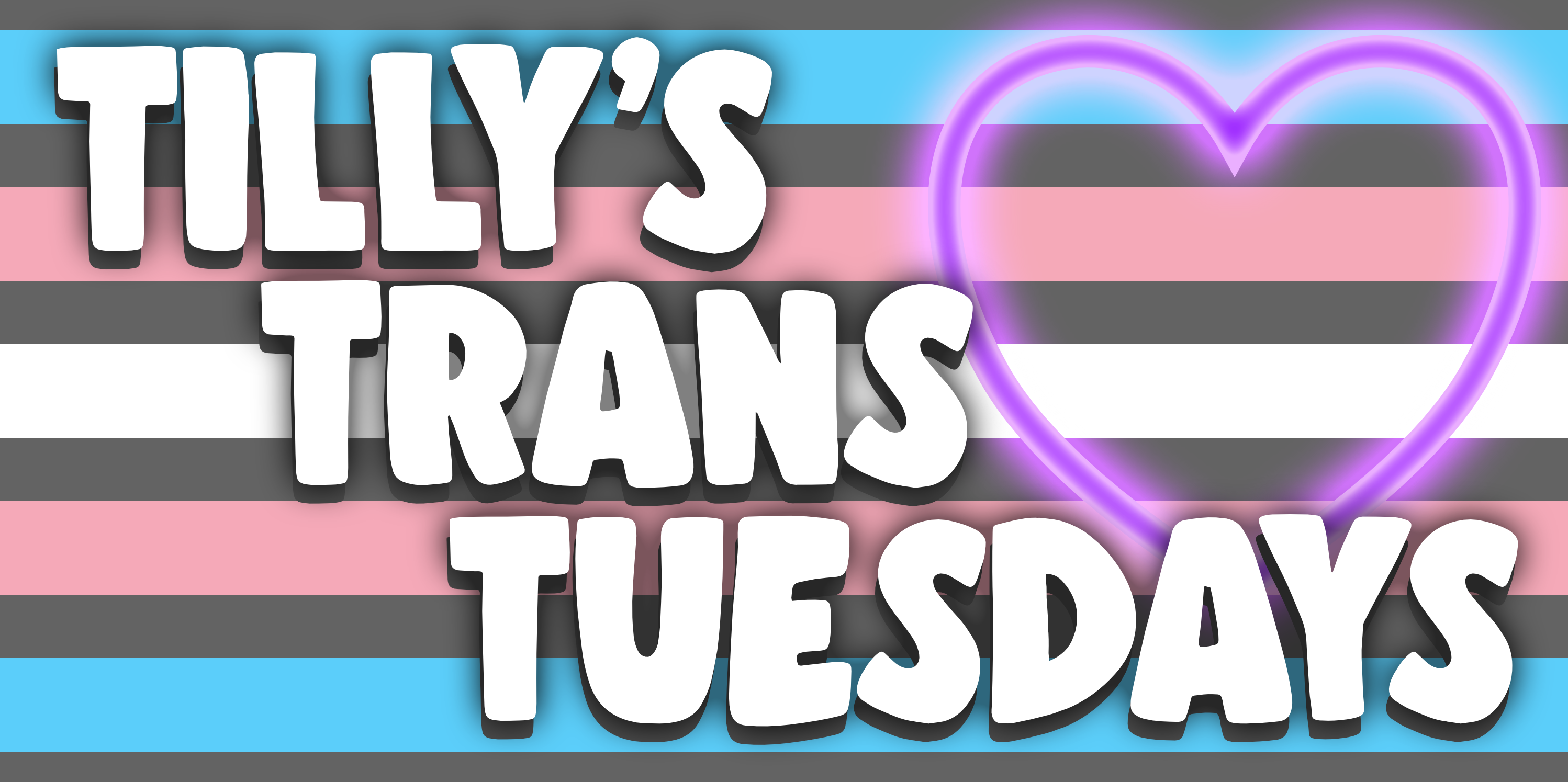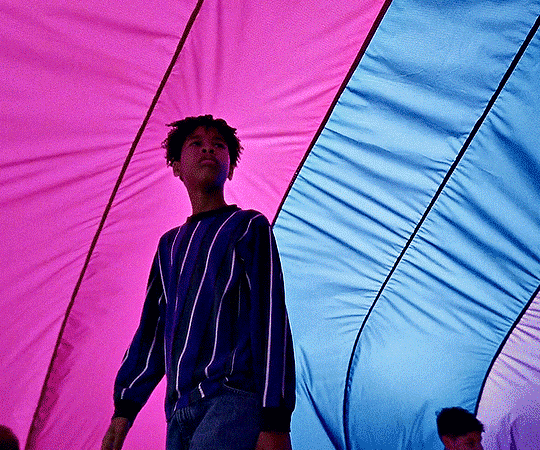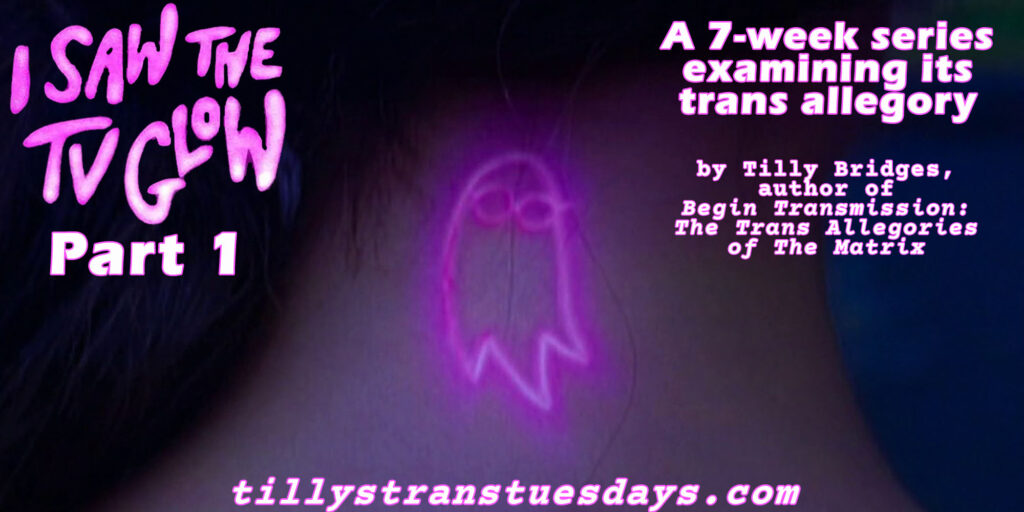
Welcome to #TransTuesday! So so SO many people have been asking for this, and waiting for it, and I’m delighted to tell you that I took untold levels of psychic damage just to bring you: THE INTENTIONAL TRANS ALLEGORY OF I SAW THE TV GLOW, part 1!
Yes, that’s right, it’s time for another installment of Tillyvision, because the masses demanded it (but also because I really wanted to). I love doing these deep-dive breakdowns, but they’re very time consuming, much moreso than your average trans tuesday. This is why I can’t do them more often, even though I’d like to. And the list of movies and television I have to cover on them is already dauntingly long. But we’ll get there! In time.
This one was especially tough, because I Saw the TV Glow has left every trans person that I know in literal tears. It’s a really important but incredibly difficult watch, and I took six hours to go through it and take notes on it and over ten hours to write it up. It’s been difficult, as what it’s saying is not easy to get through. Because many (most?) of us trans folks lived it.
At first, though people were repeatedly asking me to do one of my trans allegory write-ups on it, I wasn’t sure if I would. I wasn’t sure if I could. But then I saw trans people missing some important things about what it was saying. And I saw cis people.. yes, even with this movie that is basically all SUPERtext (a term I coined to mean the opposite of subtext)… think this is only a story about a kid who’s obsessed with a tv show.
And so I knew I had to. Art is subjective, of course, and everyone takes something different from it. But I feel like a lot of people, cis and trans alike, have missed some of what the movie itself lays out for you to interpret. Especially the ending.
So I knew I had to tackle this, but I didn’t know how. At first I thought I’d eschew my regular timestamp breakdown and talk about it more broadly, maybe in only one or two essays. But when I began my research and note-taking rewatch, I realized that it was much too densely packed with brilliance for that.
But at first, look, this is hard to explain. This movie feels… sacred to me. It is holy. It is the clearest depiction I’ve EVER seen put to film of the war with gender dysphoria, and what it does to those of us who have it. It’s so accurate it hurts. SO MUCH.
It’s so important because this is our pain. This is our lives (such as they were). And so it feels a little like blasphemy to break it down piece by piece. And I worried that in doing so, I’d lose so much of what it meant to me.
The good news is that didn’t happen, I only find it more sacred now. But having to break it down in this way wounded me deeply, because it meant diving into and examining the most painful part of my life (and the most painful part of life for, I’d wager, every trans person who’s struggled with dysphoria).
At times, this will not be an easy read. Because the movie isn’t an easy watch (not because it’s bad or harmful or bigoted, but because it’s so true to our pain). But it’s important.
It’s so, so important to talk about this, to help people understand.
THIS IS WHAT WE”RE DEALING WITH.
Grab somebody you love, who will hold you after watching and reading, because we’re all going to need it.
It should also go without saying, but… massive spoilers ahead.
Buckle up, my babies. Here we go.
Right up front, let’s just get this out of the way. The story is about two trans people, Isabel and Tara, who have been forced down into the false cis shells of Owen and Maddy. So to make this as abundantly clear as I can: THE WORLD OF THE PINK OPAQUE IS THE REAL WORLD.
Writer/director Jane Schoenbrun (who is trans) confirms this themselves in the commentary.
This means everything you see with Owen and Maddy is not real. But how can that be? It’s going to take this entire series of essays to explain that to you.
But note that two other mega intentional allegories for transness, the Matrix franchise and the Barbie movie, both ALSO deal with false realities and determining what is “real” (for that matter, so does season one of Silo, which I also did a series of essays about).
This is a common thing for trans folks, because we spend our lives gaslit by basically the entire world that everything we know and feel about ourselves is wrong and cannot possibly be true.
Yet it doesn’t change how we feel, or what we know. And so reality doesn’t feel real, because it’s not. This is what being forced to live a lie and told you’re wrong about your own sense of self does to you.
FOR CLARITY, I will refer to Owen by he/him and Maddy by she/her. But Owen’s true self is Isabel (she/her) and Maddy’s true self is Tara (they/them).
I believe the chalk you see on the street at key points in the film is an indication of Owen’s present mental state, of what’s going on in his head.
And much like with THE MATRIX, which I wrote a whole book about, and with my essays on THE INTENTIONAL TRANS ALLEGORY OF BARBIE, I Saw the TV Glow uses color as a key part of its allegory.
PINK is the most important, where it stands for transness, or access to your transness, transition, etc. The very name of the “show” (the true reality) that Owen and Maddy are obsessed with, The Pink Opaque, is also part of this.
“Opaque” is there because this movie is from the perspective of Owen, a pre-transition, pre-egg-crack trans woman, and when you exist in that state, your own transness is a mystery to you. It’s opaque, you cannot see through it to what waits on the other side. (for those unfamiliar with trans colloquialisms, an “egg” is someone who doesn’t realize they’re trans yet, and their “egg cracking” is when they realize they’re trans)
In fact, this is also why The Pink Opaque tattoo is a pink ghost. Pink = trans, ghost = spirit. It’s a signifier that your spirit, your soul, your true inner self is trans.
Also of huge importance is GREEN, which is representative of gender dysphoria.
BLUE is despair. RED is a danger warning (for both real and imagined dangers). YELLOW (as in the Matrix films) is fear.
“Owen” has a mixed and indefinite meaning, but could mean “sheep,” “good/desire,” or “born of”. But when you look at all of those, for a person who’s trans and doesn’t know it or why their life is miserable… hits kinda hard, doesn’t it?
“Isabel” traces back to Elizabeth, which means “my god is an oath.” Oaths are promises about your future actions, and Isabel is the future (and true) person Owen will become. I don’t think this is saying that Owen sees his true form of Isabel as a god, but…
Like, pre-transition and even early in transition, I would think of my potential “final form” as something sacred, a blissful, happy existence I hoped to one day achieve (and I did! And you can too!). So to me, that’s what this is implying. Isabel is the “otherworldly, divine” form Owen wishes he could be (even if he can’t admit that to himself).
“Maddy” could be short for Madeleine or Madison, so let’s look at both. “Madeleine” traces back to Magdalene, from Mary Magdalene in the Christian New Testament. Jesus cleansed her of evil spirits, and she then stayed with him through his sacrifice. That sure reads like ridding yourself of dysphoria to sacrifice your false form and attain the divinity of your true form, doesn’t it?
“Madison” traces back to Matilda, which means “strength in battle.” This is also what “Tilly” means, btw, so now you know to not mess with me 😌
And this is fascinating because of the two, Maddy is definitely the strong one… and even takes the place of a weapon during the movie, which we’ll talk about way down the line.
But BOTH of those meanings work for “Maddy,” which is pretty genius.
“Tara” means “elevated place,” which suuuuuuuure is what you could call the post-transition, final form of a trans person! It could also mean “star” which is… elevated and in the heavens, shining like a beacon. Both of those meanings work for “Tara!”
I love when we writers do this shit. 💜
I also believe that Owen’s mom is a stand-in for his femininity, and his dad is a stand-in for his masculinity. For many of us, our mothers and fathers are our first examples of access to both femininity and masculinity, and that shapes a lot of how we see both of those things.
Okay, time for timestamps! Special shout-out and thanks to Millicent Alexis Book for helping me obtain some of the screenshots you will see across all parts of this deep-dive.
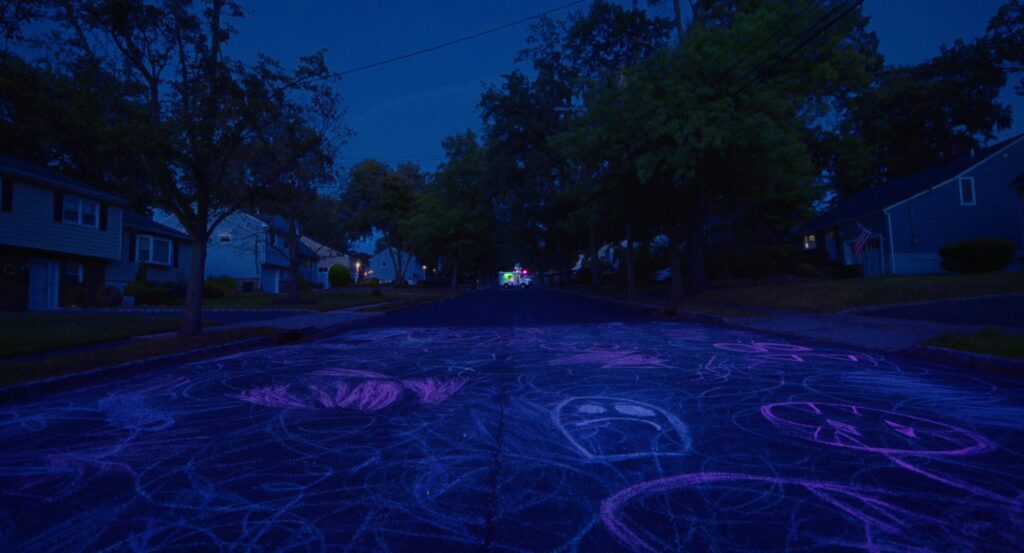
0:33 – Our first chalk drawing, setting up Owen’s internal state. Most prominent in there is the sad blue ghost. You’ve already seen the movie, so you know The Pink Opaque symbol of transness is a pink ghost with glasses and wide-open eyes. What do glasses help you do? SEE CLEARLY. This ghost is blue – despair. Its eyes are clouded and can’t see things clearly.
This is a direct and clear indication that Owen is the furthest from his true self, from transition. Inside, he’s a mess (weren’t we all). We’ll get to the ice cream truck at the end of the street in a little bit, when there’s a clearer shot of it, but note that’s where this path he’s on right now will lead him.
1:11 – Young Owen’s watching tv, changing channels. He’s searching for… something. Meaning. Clues about himself. Answers to questions he doesn’t know how to ask. I did this too! Many trans people do. See the Trans Tuesday on SEARCHING FOR MEANING WHEN YOU’RE TRANS (and don’t know it).
1:20 – The screen and his face go pink (transness is here!) in a commercial for The Pink Opaque. This is his first encounter with the idea and concept of transness, even if he can’t name it or understand it. Something in him is saying wait, my life is wrong, the world is wrong, this is not who I am, this is not reality.
1:28 – “Isabel’s BATHROOM has a new supernatural infestation that no exterminator can take care of.” Bathrooms are the most heavily gendered spaces we have (the Matrix uses them specifically for this same reason).
A “supernatural infestation” is gender dysphoria. It infests your mind, and is a power you cannot control (pre-transition). And no, no exterminator or specialist or outside person can fix it. ONLY WE CAN. The Matrix again deals with this exact same thing. No one is coming to save us but US.
WE are “The One” we’ve been waiting for to save us.
Isabel, in a pink dress (Isabel is the true Owen, pink = trans), leaps out the bathroom window between green (dysphoria) curtains. Transition lets her slip past dysphoria!
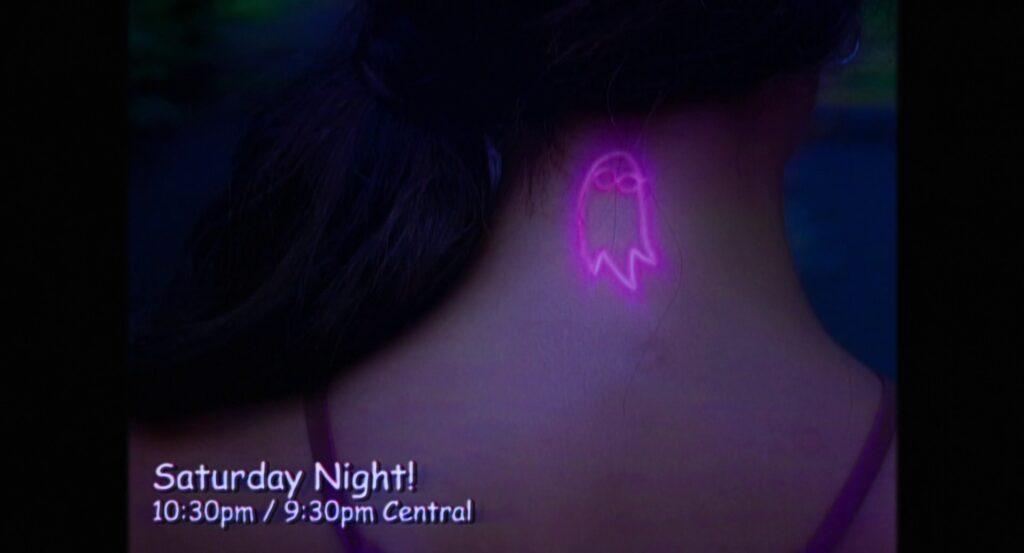
Isabel walks down the street with an axe, and has the pink opaque tattoo, which we can see is the polar opposite of the ghost drawing in the opening chalk shot.
She’s then walking with the axe on a football field, and gives a slow sad wave, like she wants someone to notice her or is saying goodbye. Which is basically saying “Here I am, Owen, notice me, BE me, or you’re going to lose me.” Remember this for when we talk about the football field later on.
Also, football fields are a very traditionally male space, spaces where trans women pre-transition often find ourselves (not exactly on football fields, but you know what I mean… in spaces for men. This is metaphor!). But she has an axe, and is ready to fight.
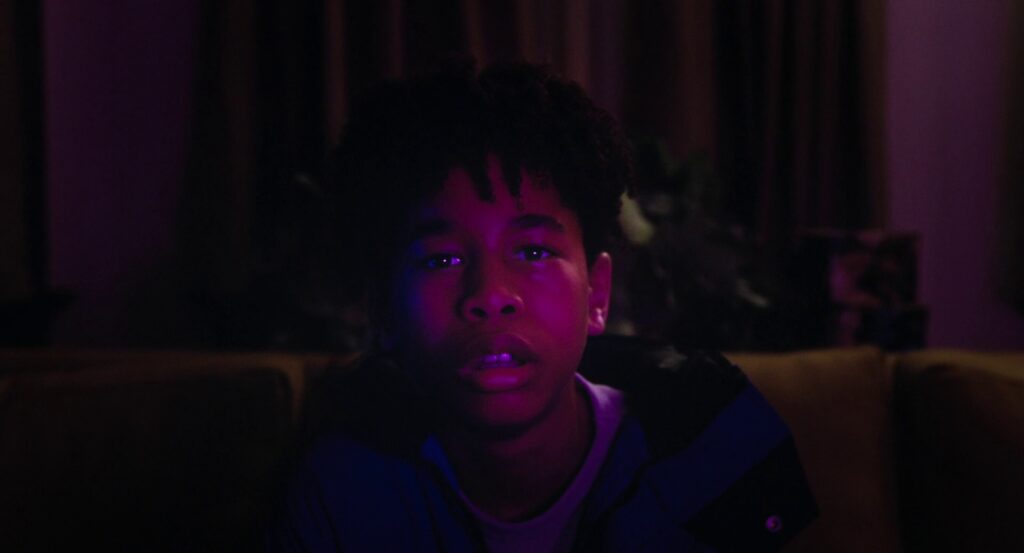
1:40 – “They can’t hurt you if you don’t think about them,” said from the tv while Owen’s face is in pink, and he seems mesmerized. This is what I, and many other trans people, told ourselves about our weird and complicated gender feelings all our lives.
If we just don’t think about it, it can’t hurt us and we won’t have to do anything about it!
Because that always works. Oy.
“Anthems for a Seventeen Year-old Girl” by Yeule plays. The title sure says a lot, and I’m not going to quote all the lyrics, but it can definitely be read as a person leaving their fake life behind and changing into someone new, but being super uncomfortable with it and wishing they weren’t trans. Here’s a small excerpt:
Used to be one of the rotten ones and I liked you for that
Now you’re all gone, got your make-up on, and you’re not coming back
Can’t you come back?
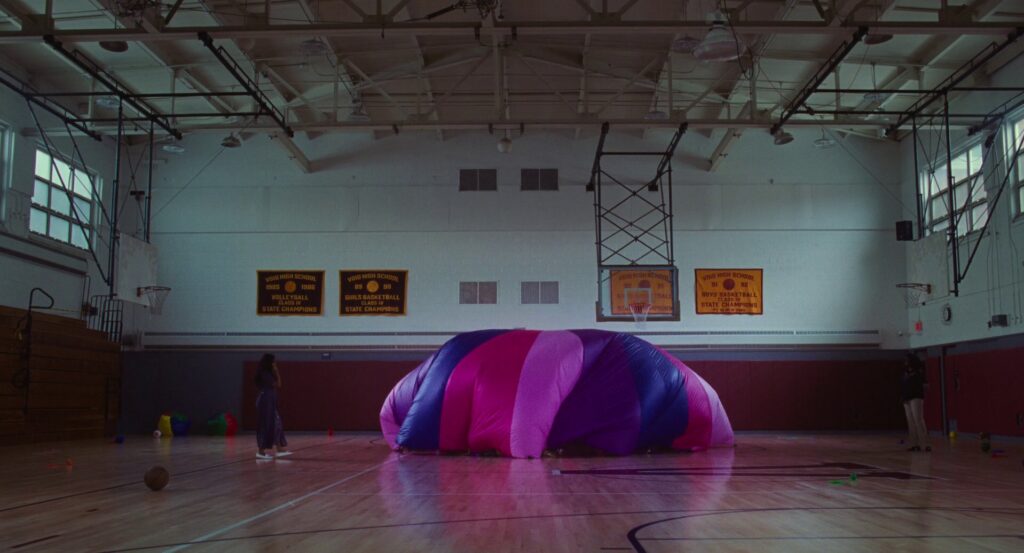
2:00 – The colors are very trans pride flag adjacent as we cut to the parachute and young Owen walking inside it. His first encounter with his transness has opened him up, this feels representative of him exploring the feelings inside about his transness.
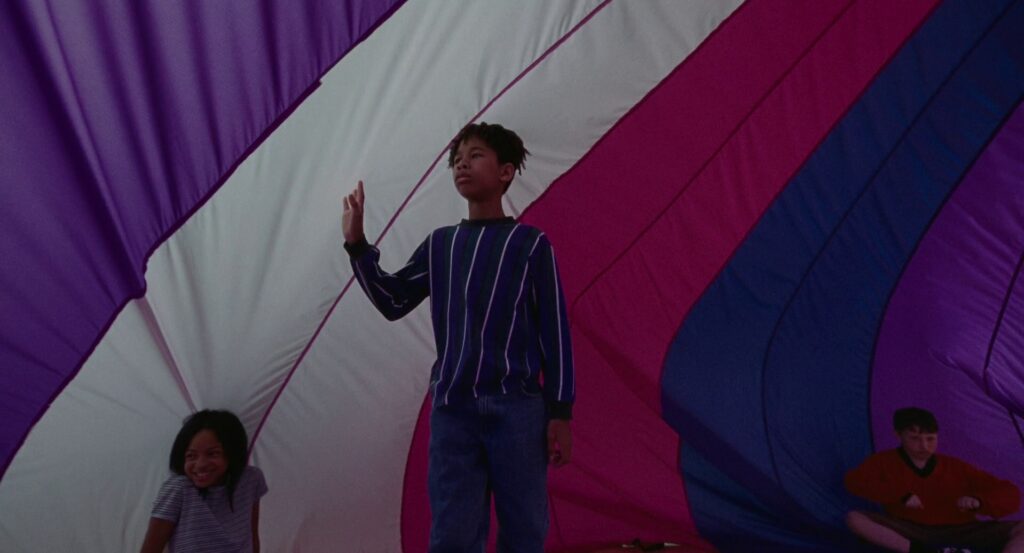
All the other kids are just playing, but he’s walking (searching?) alone. This is foreshadowing the inflatable planetarium near the end of the film, where he has an important choice to make. But here, there’s no choice, only exploration of what he finds within.
3:16 – Teen/adult Owen: “It was raining last night and I couldn’t sleep, so I started my favorite TV show again. The Pink Opaque.” He keeps coming back to transness. Also, though we haven’t seen it happen in the movie yet, you’ve watched it already and know when Owen first goes to Maddy’s house to watch the show… it’s raining.
The rain reminds him of the first time he truly connected with his inner self and his transness, so he puts the show on again.
And I think this fire we see him looking at here is his inner fire, his desire to become and exist as his true self. He’s staring at it, contemplating, trying to make his choice. It’ll take him the rest of the movie to make it.
But you can tell what’s informing the interim choices he makes, look at the light on his face. Yellow. Fear.
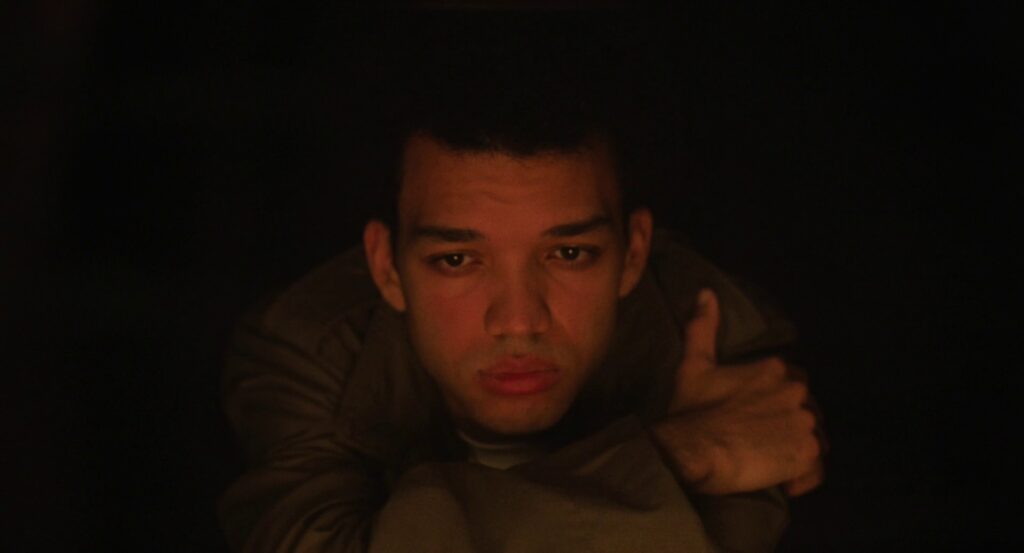
He tosses something on the fire, it flares, and then he sits and looks at it with sad, dead eyes. This is what the eyes of every trans person pre-transition look like in our photos, mine included. It’s tremendous acting from Justice Smith.
4:14 – Young Owen is at Void High with his mom, who is voting. In the commentary, Jane Shoenbrun said the school they shot in already began with a V and it would cost too much to change it (especially on the football field), so they just picked a word that started with V. But “void” is perfect, because life is very much like a void pre-transition.
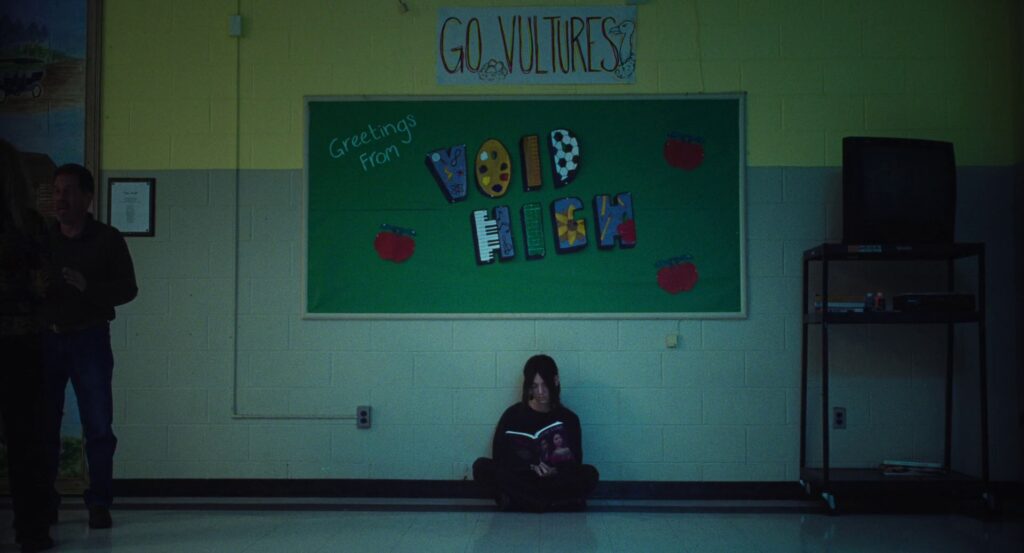
4:47 – Owen sees Maddy for the first time. Also pay attention to the school mascot being vultures, which is very much what it feels like every transphobic cis person in the world is… circling you, waiting for you to fall so they can pick your carcass clean.
Maddy’s reading The Pink Opaque episode guide. She leaves, he watches her go, his face in a blue light. In his first sight of Maddy, he saw in her the same thing he saw in the ad for the show… something he recognized within himself, but couldn’t identify. And it makes him sad, maybe because he wishes he could be like her (having access to transness with the episode guide).
I’ve mentioned in multiple trans tuesdays how I had a friend pre-transition, that I always felt this intimate connection with that I couldn’t explain, different from just friendship (and it wasn’t romantic or sexual). I had no idea what it was. We lost touch, reconnected a few years into my transition… and she’d transitioned, too. It happens. We can’t define it, but sometimes we can see it in each other.
Owen’s mom calls him to the voting booth. Look at the yellow curtains.
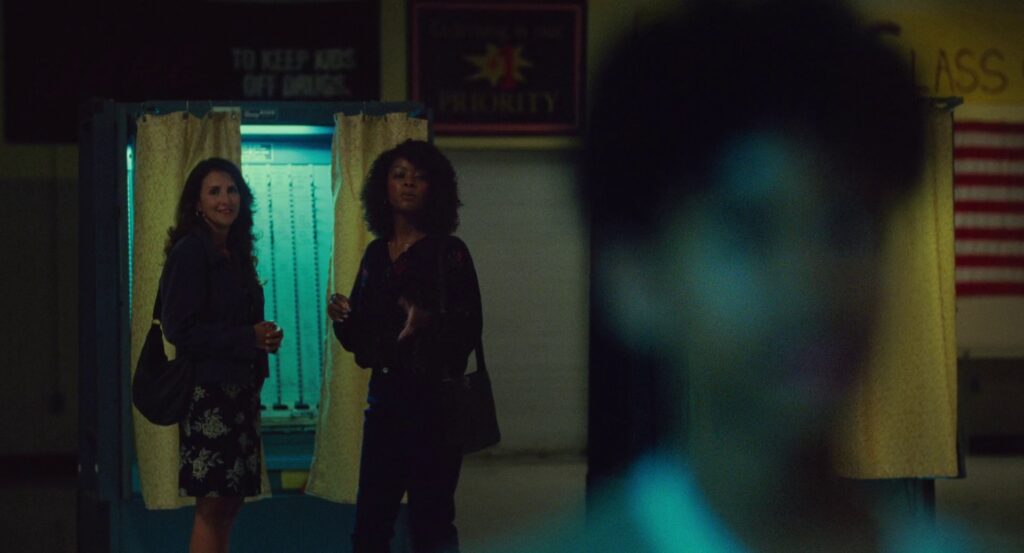
Why would he fear the voting booth? Well he doesn’t, but it’s symbolic of what he does fear. Because what is voting?
A choice for the future.
And what does Owen have trouble making through the entire movie? A choice for his future. It terrifies him.
You’ll see yellow used a LOT in this way during the movie if you watch for it… veils or barriers between Owen and that which he fears. Our fear keeps us from what we desire, keeps us from ourselves. Our true selves.
Once he’s in the voting booth, look at the lighting on all the choices… it’s a blue-green. Dysphoria and despair are all he sees as his options.
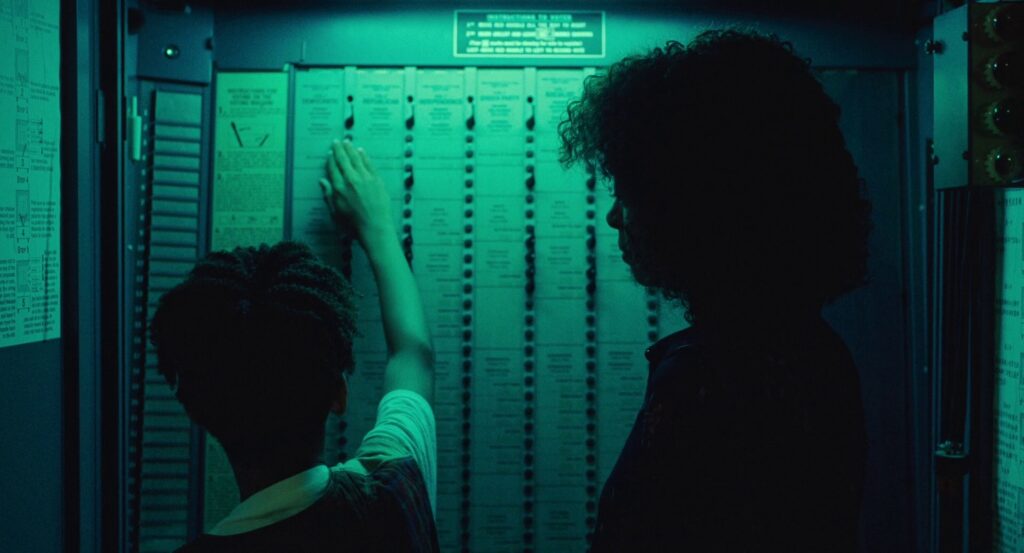
6:01 – Owen walks the school hall, past signs that it’s too dark to read. Those signs are important, but note that right now, at this age, they’re just shadows to him. Unclear. He hasn’t absorbed their messages yet. We’ll discuss them more later on, when they’re clear to him.
6:29 – As he walks through the cafeteria, the tables have been turned upside down. In the commentary Jane says they’re “like turtles.” If you turn a turtle on its back, it can’t move or right itself. It’s vulnerable. They’re trying to convey to you that Owen is in a vulnerable state here, his mind having started to wonder about his true identity and not being able to make sense of it.
Genius little detail, I tell you what.
In here, the Fruitopia machine (a very bright pink) is a huge “there is transness here!” sign. In the commentary, Jane said it “announces ‘welcome,’” and to a kid looking for more information about his own transness, yeah, it would.
We’ve barely gotten started, but we’re gonna break there for this week. There’s so much more to show you.
Tilly Bridges, end transmission.
tillysbridges@gmail.com
